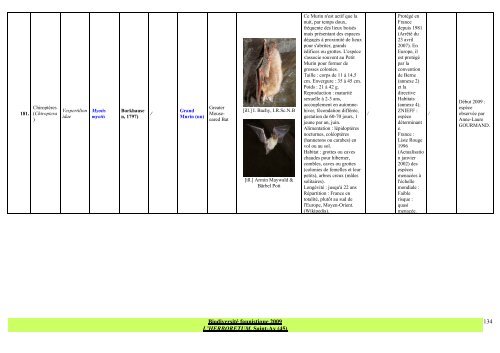téléchargez l'étude - Association de L'Herboretum
téléchargez l'étude - Association de L'Herboretum
téléchargez l'étude - Association de L'Herboretum
You also want an ePaper? Increase the reach of your titles
YUMPU automatically turns print PDFs into web optimized ePapers that Google loves.
181.<br />
Chiroptères<br />
(Chiroptera<br />
)<br />
Vespertilion<br />
idae<br />
Myotis<br />
myotis<br />
Borkhause<br />
n, 1797)<br />
/<br />
Grand<br />
Murin (un)<br />
Greater<br />
Mouseeared<br />
Bat<br />
[ill.] I. Bachy, I.R.Sc.N.B<br />
[ill.] Armin Maywald &<br />
Bärbel Pott<br />
Biodiversité faunistique 2009<br />
L’HERBORETUM, Saint-Ay (45)<br />
Ce Murin n'est actif que la<br />
nuit, par temps doux,<br />
fréquente <strong>de</strong>s lieux boisés<br />
mais présentant <strong>de</strong>s espaces<br />
dégagés à proximité <strong>de</strong> lieux<br />
pour s'abriter, grands<br />
édifices ou grottes. L'espèce<br />
s'associe souvent au Petit<br />
Murin pour former <strong>de</strong><br />
grosses colonies.<br />
Taille : corps <strong>de</strong> 11 à 14,5<br />
cm. Envergure : 35 à 45 cm.<br />
Poids : 21 à 42 g.<br />
Reproduction : maturité<br />
sexuelle à 2-3 ans,<br />
accouplement en automnehiver,<br />
fécondation différée,<br />
gestation <strong>de</strong> 60-70 jours, 1<br />
jeune par an, juin.<br />
Alimentation : lépidoptères<br />
nocturnes, coléoptères<br />
(hannetons ou carabes) en<br />
vol ou au sol.<br />
Habitat : grottes ou caves<br />
chau<strong>de</strong>s pour hiberner,<br />
combles, caves ou grottes<br />
(colonies <strong>de</strong> femelles et leur<br />
petits), arbres creux (mâles<br />
solitaires).<br />
Longévité : jusqu'à 22 ans<br />
Répartition : France en<br />
totalité, plutôt au sud <strong>de</strong><br />
l'Europe, Moyen-Orient.<br />
(Wikipedia).<br />
/<br />
Protégé en<br />
France<br />
<strong>de</strong>puis 1981<br />
(Arrêté du<br />
23 avril<br />
2007). En<br />
Europe, il<br />
est protégé<br />
par la<br />
convention<br />
<strong>de</strong> Berne<br />
(annexe 2)<br />
et la<br />
directive<br />
Habitats<br />
(annexe 4).<br />
ZNIEFF :<br />
espèce<br />
déterminant<br />
e.<br />
France :<br />
Liste Rouge<br />
1996<br />
(Actualisatio<br />
n janvier<br />
2002) <strong>de</strong>s<br />
espèces<br />
menacées à<br />
l'échelle<br />
mondiale :<br />
Faible<br />
risque :<br />
quasi<br />
menacée.<br />
/<br />
Début 2009 :<br />
espèce<br />
observée par<br />
Anne-Laure<br />
GOURMAND.<br />
134


